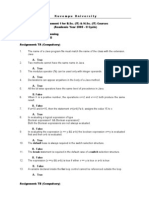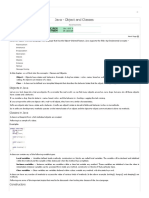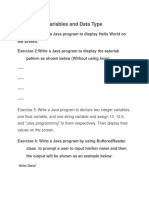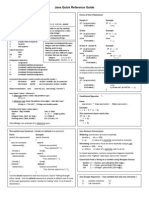Java Quick Reference Guide
Uploaded by
amarJava Quick Reference Guide
Uploaded by
amarJava Quick Reference Guide [Jack Wilson – Cerritos College]
Last Update: Tuesday, February 16, 2016
Arithmetic Operators Remember to use the methods Forms of the if Statement
+ Addition equals( ) or compareTo( ) when comparing
- Subtraction Strings rather than relational comparison Simple if Example
/ Division (int / floating-point) operators. if (expression) if (x < y) The
2/3 = 0, 2.0/3.0 =.666667 statement; x++; "expression" in
String s1 = "abc", s2 = "def";
* Multiplication the parentheses
% Modulus (integer remainder) String Comparison expressions: if/else Example
for an
Compare for equality: if (expression) if (x < y)
Relational/Equality Operators
s1.equals(s2) or statement; x++; if statement
< Less than else else
<= Less than or equal to s1.compareTo(s2) == 0
statement; x--; or
> Greater than Remember the compareTo( ) method
>= Greater than or equal to returns one of 3 values: if/else if (nested if) Example loop
== Equal to neg number, pos number, 0 if (expression) if (x < y)
!= Not equal to is often also
Compare for lexical order: statement; x++;
referred to as a
Logical Operators s1.compareTo(s2) < 0 (s1 before s2) else else
if (expression) if (x < z) "condition"
! NOT s1.compareTo(s2) > 0 (s1 after s2)
&& AND statement; x--;
|| OR else else
Remember to distinguish between integers
statement; y++;
Assignment Operators and real numbers (called floating-point in
= simple assignment Java). These are stored differently in To conditionally execute more than one statement, you must
+= addition/assignment memory and have different ranges of create a compound statement (block) by enclosing the statements
-= subtraction/assignment values that may be stored. in braces ( this is true for loops as well ):
*= multiplication/assignment integer: 2, 3, -5, 0, 8
Form Example
/= division/assignment floating-point: 2.0, 0.5, -3., 4.653 if (expression) if (x < y)
%= modulus/assignment
{ {
Increment ++ /Decrement -- operators used in prefix and postfix modes statement; x++;
++/-- prefix mode - inc(dec) variable, use variable in the larger expression statement; System.out.println( x );
++/-- postfix mode - use variable in larger expression, inc(dec) variable } }
Object Creation: ( new ) new int[ 10 ], new GradeBook("CIS 182")
The new operator creates an object and returns a reference (address of an object)
Input using Scanner class
Java Types [value/reference ] Scanner input = new Scanner ( System.in ); //keyboard input
A value type stores a value of a primitive type int x = 3; input methods: next(), nextLine(), nextInt(), nextDouble()
A reference type stores the address of an object Circle c = new Circle(2);
A reference variable is created using a class name: GradeBook myGradeBook; Output methods for System.out or PrintWriter objects
print(), println(), printf() [formatted output]
Primitive Data Types ( Java value types ) Remember: String is a reference type
boolean flag / logical true, false [ boolean literals ] Input/Output using JOptionPane class [ package javax.swing ]
char character 'A', 'n', '!' [ char literals ]
byte, short, int, long integral 2, 3, 5000, 0 [ int literals ] String numString; int num;
float, double floating-point 123.456, .93 [ double literals ] numString = JOptionPane.showInputDialog("Enter a number");
Default numeric literal types: num = Integer.parseInt(numString);
integral: int int x = 3; //3 is an int literal JOptionPane.showMessageDialog(null, "Number is " + num);
floating-point: double double y = 2.5; //2.5 is a double literal
Most commonly used reference type in Java is String. String name = "Jack";
Conversion from a String to a number using Wrapper Classes
double d = Double.parseDouble(dString);
The switch case Construct ( break and default are optional ) float f = Float.parseFloat(fString);
int j = Integer.parseInt(jString);
Form: Example:
switch (expression) switch (choice) Java formatted output [ printf( ) and String.format( ) methods ]
{ {
3 components: format string and optionally: format-specifiers ( fs )
case int-constant : case 0 :
and an argument list ( al )
statement(s); System.out.println( “You selected 0.” );
fs: " ... % [flags] [width] [precision] format-specifier ... "
[ break; ] break;
al: comma separated list of expressions
case int-constant : case 1: Format-specifiers: s (string), d (integer), f (floating-point)
statement(s); System.out.println( “You selected 1.” ); Example: System.out.printf("Total is %,10.2f%n", total);
[ break; ] break;
[ default : default : Java Numeric Conversions and Casts:
statement; ] System.out.println(
“You did not select 0 or 1.” ); Widening conversions are done implicitly.
} } double x; int y = 100;
x = y; // value from y implicitly converted to a double.
The "expression" and “int-constant” are usually type int or char. Java 7
adds the ability to use a string. switch(behavior) { case “good”: … } Narrowing conversions must be done explicitly using a cast.
double x = 100; int y;
Use the break keyword to exit the structure (avoid “falling through” other y = (int) x; // value from x explicitly cast to an int
cases). Use the default keyword to provide a default case if none of the
case expressions match (similar to a trailing “else” in an if-else-if In mixed expressions, numeric conversion happens implicitly.
statement). double is the “highest” primitive data type, byte is the “lowest”.
Java Quick Reference Guide [Jack Wilson – Cerritos College]
Last Update: Tuesday, February 16, 2016
The while Loop ( pre-test loop ) The for Loop ( pre-test loop )
Form: Example: Form: Example:
for (init; test; update) for (int count=1; count<=10; count++)
init; x = 0;
{ {
while (test) while (x < 10) statement; System.out.println( count );
{ { } }
statement; sum += x;
update; x++; Enhanced for loop: for (parameter : collection)
} } statement;
int scores[ ] = {85, 92, 76, 66, 94}; //collection is the array scores
for ( int number : scores ) //parameter is the variable number
The do-while Loop ( post-test loop ) System.out.println(number);
Form: Example: Escape Sequences Operator Precedence
init; x = 0; Special characters in Java (1) mathematical (2) relational (3) logical
do do
\n newline character '\n' ( )
{ { ----------
\t tab character '\t'
statement; sum += x; *, /, % [ mathematical ]
\" double quote '\"'
update; x++; ----------
\' single quote '\''
} while (test); } while (x < 10); +, -
\\ backslash '\\'
Logical operators: !, &&, ||
Selection and Loop Structures Use the ArrayList class to
Java Arrays: Create an array ( 2 ways )
create a dynamically
Selection: 1. <type> <array-name>[ ] = new <type>[size]; resizable array.
Unary or single selection 2. <type> <array-name>[ ] = { <initializer-list> };
Binary or dual selection The Arrays class has static
Case structure possible when //create an array of 20 elements. methods that can be used
int myArray[ ] = new int[20]; with arrays and ArrayLists to
branching on a variable
Simple selection //create an array of 3 elements set to the values in the initializer list. search, sort, copy, compare
One condition int myArray[ ] = { 1, 2, 3 }; for equality, etc.
String stooges[ ] = { "Moe", "Larry", "Curly" };
Compound selection int num[ ]; … <stmts> ….
Multiple conditions joined //assign value of first element in myArray to the integer variable x.
with AND / OR operators int x = myArray[0]; Create a new initialized
//assign value of the last element in myArray to the integer variable y. array and assign to num.
Looping: num = new int[ ]{1,2,3,4,5};
int y = myArray[ myArray.length-1 ];
Java Pre-test loops
Test precedes loop body All arrays have a public field named length which holds the number of elements in the array.
while
Given this declaration: int x[][][];
for
Java Post-test loop x.length is the number of elements in the array in the first dimension.
Test follows loop body x[m].length is the number of elements for a specific array in the second dimension.
do-while x[m][n].length is the number of elements for a specific array in the third dimension.
Loop Control: Java Methods: <modifier(s)> <type> <method-name> ( [<type> param1] [, <type> param2] [, … ] )
3 types of expressions that A Java method can return a single value using a return statement: return <expression>; If a method
are used to control loops: will not return a value, the return type void is used in the method header. The return statement return;
may be used if needed or left out (causing an implicit return at the end of the method).
initialization ( init )
test void printHeadings( ) //no parameters, return type is void
update { <method body> }
Counter-controlled loops, void printDetailLine( String name, int number, double gpa )//33.141592635…
Math.PI parameters, return type is void
aka definite loops, work with { <method body> }
a loop control variable (lcv)
int getCount( ) //no parameters, return type is int
Sentinel-controlled loops, { <method body> }
aka indefinite loops, work
double max( double x, double y ) //2 parameters, return type is double
with a sentinel value
{ <method body> }
Java Loop Early Exit: When a method is called, the data is passed to the parameters (if any) using arguments
break statement
//Arguments: "Jack Wilson", 100, 3.50 passed to Parameters: name, number, gpa for Method:
Note: The break statement can printDetailLine (see method header above) : printDetailLine( "Jack Wilson", 100, 3.50);
be used with a switch
statement or a loop in A method may be declared with one variable length parameter. It must be the last parameter declared.
Java. Loops may also use The syntax of the declaration is <type> ... <parameter-name>. Spacing doesn’t matter.
a continue statement. Examples: int... numbers, double ... values, String ...names //implicit array creation
You might also like
- Java Quick Reference Guide: String ComparisonsNo ratings yetJava Quick Reference Guide: String Comparisons2 pages
- Final Exam in CS 122 Java Programming: Submitted By: Abby Rose L. Abraham Bsit 2A Submitted To: Prof. Josan TamayoNo ratings yetFinal Exam in CS 122 Java Programming: Submitted By: Abby Rose L. Abraham Bsit 2A Submitted To: Prof. Josan Tamayo5 pages
- BSC Sem4 Java Programming Assignment 1 AnsNo ratings yetBSC Sem4 Java Programming Assignment 1 Ans5 pages
- Notes On JAVA 10.2005.3: Syntax of CommandsNo ratings yetNotes On JAVA 10.2005.3: Syntax of Commands3 pages
- Oracle 1Z0-809 Exam Practice Dumps DownloadNo ratings yetOracle 1Z0-809 Exam Practice Dumps Download8 pages
- JAVA QUESTIONS 1 (24.1.22) : A. 1, 2, 4 B. 2, 4, 5 C. 2, 3, 4 D. All Are Correct. Answer: Option ANo ratings yetJAVA QUESTIONS 1 (24.1.22) : A. 1, 2, 4 B. 2, 4, 5 C. 2, 3, 4 D. All Are Correct. Answer: Option A9 pages
- Embedded System Design A Unified Hardware Software Introduction Frank Vahid PDFNo ratings yetEmbedded System Design A Unified Hardware Software Introduction Frank Vahid PDF174 pages
- Microsoft Windows Communication Foundation 4.0 Cookbook for Developing SOA ApplicationsFrom EverandMicrosoft Windows Communication Foundation 4.0 Cookbook for Developing SOA ApplicationsNo ratings yet
- Group Theory in Solid State Physics and Photonics: Problem Solving with MathematicaFrom EverandGroup Theory in Solid State Physics and Photonics: Problem Solving with MathematicaNo ratings yet
- Java-Quick-Reference-Guide-bscs-bahria UniversityNo ratings yetJava-Quick-Reference-Guide-bscs-bahria University2 pages
- Funadamental Programming structures in JavaNo ratings yetFunadamental Programming structures in Java88 pages
- Fast VP For Emc Symmetrix Vmax Theory and Best Practices For Planning and PerformanceNo ratings yetFast VP For Emc Symmetrix Vmax Theory and Best Practices For Planning and Performance35 pages
- Chapter 12 - Sorting and Searching AlgorithmsNo ratings yetChapter 12 - Sorting and Searching Algorithms4 pages
- Single-Dimensional Arrays: 7.2.1 Declaring Array VariablesNo ratings yetSingle-Dimensional Arrays: 7.2.1 Declaring Array Variables23 pages
- Data Structures and Algorithm Q1 Finals 2No ratings yetData Structures and Algorithm Q1 Finals 261 pages
- Q.1 Fill in The Blanks.: (Ch#14) File Handling in C Computer Science Part-IINo ratings yetQ.1 Fill in The Blanks.: (Ch#14) File Handling in C Computer Science Part-II7 pages
- Phased Array Design Using Mathworks and ANSYS - 01No ratings yetPhased Array Design Using Mathworks and ANSYS - 018 pages
- Questions On Assigning Object, Pointer To Objects, Passing and Returning ObjectNo ratings yetQuestions On Assigning Object, Pointer To Objects, Passing and Returning Object40 pages
- Chapter 3: Operators and Assignments Java OperatorsNo ratings yetChapter 3: Operators and Assignments Java Operators14 pages
- Two-Dimensional Arrays: By: Jhaiona Hart FuentesNo ratings yetTwo-Dimensional Arrays: By: Jhaiona Hart Fuentes12 pages
- Data Structures Using C++ 2E: Pointers and Array-Based ListsNo ratings yetData Structures Using C++ 2E: Pointers and Array-Based Lists37 pages

























































































